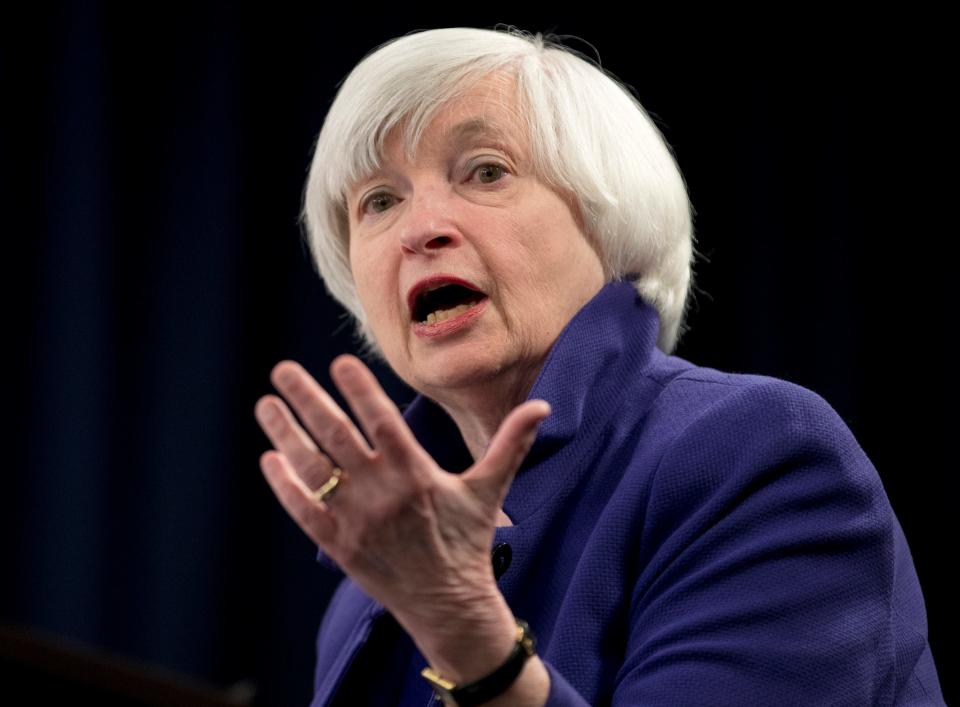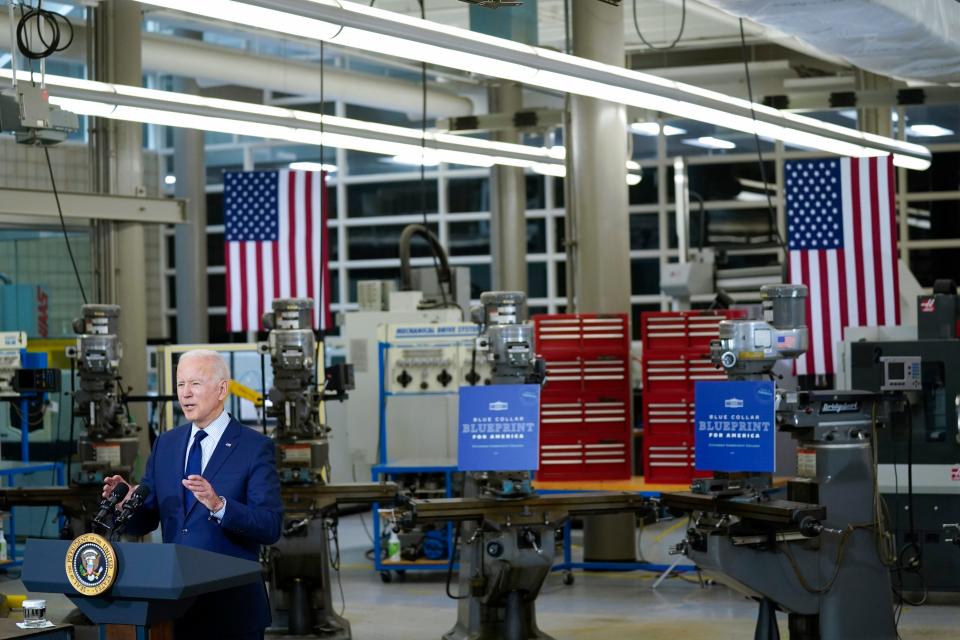White House, Federal Reserve push back on inflation concerns as prices shift
WASHINGTON — As Americans emerge from lockdown eager to resume activities suspended during the pandemic, policymakers and financial analysts have turned their attention to one data point that may slow the fun: inflation.
The post-coronavirus economic recovery is set to be the fastest in decades, with the U.S. growing at a 6.4% annualized rate in the first quarter, the second-best quarterly reading since 2003. But it also comes with quirks perplexing economists and policymakers in some ways, including the state of labor and financial markets, the role of government stimulus and inflation.

“We have in recent months seen some inflation, and we — at least on a year-over-year basis — will continue, I believe through the rest of the year, to see higher inflation rates, maybe around 3 percent,” Treasury Secretary Janet Yellen said during a June meeting of the G-7 financial ministers in London.
The Bureau of Labor Statistics reported a 5% year-over-year increase in prices from May 2020, the sharpest increase in over a decade. The jump surprised Federal Reserve analysts and alarmed markets.
On June 8, the White House announced the creation of a task force targeting supply chain shortages and resulting inflation. The team, headed by Transportation Secretary Pete Buttigieg, Commerce Secretary Gina Raimondo and Agriculture Secretary Tom Vilsack, is engaging longer-term issues like the countries shortage of microchips, while also grappling with the country's immediate shortages of some goods as the economy reopens.
In a briefing, Sameera Fazili, deputy director of the National Economic Council, said the task force would "tackle near-term bottlenecks in the semiconductor, homebuilding and construction, transportation, and agricultural and food industries."
But the White House has pushed back on narratives that inflation threatens to stifle the country's economic recovery or that the administration's policies, including the Democrats' $1.9 trillion stimulus package, are responsible for the latest numbers.
Emilie Simons, a spokesperson for the White House, told USA TODAY, that President Joe Biden's "economic plan is working." She cited downward trends in COVID-19 cases and deaths, and positive economic activity.
"Our country is experiencing a record economic recovery, with record job growth and record wages. We knew that turning the economy back on would not be like turning on a light bulb and that we would see bumps as supply chains start to normalize around the world. Thanks to President Biden’s vaccination campaign and an economic strategy that builds from the bottom out, we’re headed in the right direction," Simons argued.
Brian Deese, the director of the National Economic Council, echoed that on Wednesday.
“To the degree that people are focused on inflationary pressures in the short term, that really is not the issue. In the short term, this is an economy that is recovering very strongly,” Deese said during an interview hosted by the Atlantic Council.
Costs have risen, but general trend appears temporary
Inflation is effectively an overall rise in prices for goods in an economy. It can be caused by higher production costs or demand in the economy, as well as a general increase that comes with rising wages and standards of living.
In May, White House press secretary Jen Psaki said the White House takes the threat of inflation "quite seriously" but that "most economists believe that it will have a temporary, transitory impact" on the recovery.
In June, the Federal Reserve's Beige Book survey found that prices have risen as the cost of manufacturing, construction and raw materials have shot up during the post-pandemic boom. The survey also noted an ongoing labor shortage was causing some businesses to increase prices or shorten their hours of operation.
Some of the largest year-to-year increases recorded in the Consumer Price Index included energy and transportation services, whose prices had crashed last year at the height of coronavirus lockdowns.
Airline fares have increased 24.1% since last May, while energy costs overall rose 28.1%. While dining services like restaurants and takeout increased by 4%, food prices overall increased by 2%, within the expected increase.
Prices of other items, like apparel and used cars and trucks, also increased sharply, reflecting heightened demand in the post-COVID economy, while the cost of medical goods fell from last year.
Whether these price increases will be persistent or cause for alarm is up for debate.
"In general, consumers notice the things that go up – especially gas prices – and they tend not to notice the price of things that go down. But it’s a mishmash, and the worry is when everything goes up at the same time," said David Wessel, a senior fellow in economic studies at the Brookings Institution, a policy think tank.
"It will be interesting to see what happens to rents, which haven’t gone up a lot, and what happens to wages. Are people taking advantage of the raised wages from companies and people being able to quit their jobs?" Wessel continued.
The international nature of the rising inflation also leads economists to suggest the current trend is temporary and unique to the post-COVID economy. Just as some prices stabilized or fell in the U.S., inflation rose in Brazil, the European Union, India and Japan.
The question dogging policymakers and analysts is how much inflation the economy can sustain and when intervention may be necessary.
Economists agree that at least part of the latest round of inflation is the result of pent-up demand from consumers eager to get back to business, shopping, traveling and other activities suspended during the pandemic.
On Tuesday, though, Fed Chair Jerome Powell conceded during a congressional hearing that the latest inflation numbers had come back higher than anticipated.
He insisted, however, that it is still "very, very unlikely" the U.S. would see anything close to the level of inflation the country experienced in the 1970s and 1980s when inflation was above 10%.
“I will say that these effects have been larger than we expected, and they may turn out to be more persistent than we have expected,” Powell said. “But the incoming data are very consistent with the view that these are factors that will wane over time, and inflation will then move down toward our goals, and we’ll be monitoring that carefully.”
While some analysts argue that inflation signals an overheating economy, economists are in general agreement that the latest round of inflation figures are not the biggest problem concerning the American economy.
"The Fed and many economists have been saying that this surge in inflation that we’ve seen is largely temporary and related to the stresses of reopening the economy after the end of the pandemic," Wessel said.
"That view got a little challenged by the size of the recent price increases. People hadn’t been expecting that prices would be increasing this quickly," he continued, adding that the Federal Reserve has issued multiple statements noting the rise in prices and that any corresponding interest rate hikes remain a distant possibility.
"I don’t think the average American could care less whether the Fed raises rates in December 2022 or April 2023. It matters in the financial markets and of course that affects us all ... but I definitely don’t think there’s any cause for alarm, in fact, I would say just the opposite," Wessel said.
Many watchers of the Federal Reserve also take note that its attention to the issue is reassuring many investors, who might otherwise express alarm at the abnormality.
"I think that this is very consistent with what they’ve been saying for a long time: that their decisions are data-driven. They are watching things carefully to make sure that they fulfill their dual responsibilities for price stability and maximizing employment. And their latest announcement is pretty straightforward from that point of view," said Erica Groshen, a senior economics advisor at Cornell University and the former commissioner of the Bureau of Labor Statistics.
What will the White House do about inflation?
Regardless of its tangible near-term effects on everyday citizens, inflation presents a political challenge for the Biden administration.
GOP lawmakers have cited the latest consumer price increases and labor market shortage as lines of attack on the president, alleging that the president's policies are to blame for the contradictions in the recovery.
Rep. Jim Banks, R-Ind., told the Associated Press his constituents have “seen the higher prices on gas in particular, but also groceries and the cost to keep their businesses running" and that many "know, intuitively, that this is due to Democrats’ economic agenda and big spending plans.”

"If the gas crisis is a candle flame and lumber prices are a campfire, then growing inflation is a forest fire that has ignited, and may eventually burn through our entire economy," Sen. Ted Cruz, R-Texas, wrote on Twitter after lumber prices spiked before falling again.
While the criticism's accuracy is disputed amongst economists, Republicans hope the narrative of inflation will help them win over voters who are most concerned about the economy.
"Going forward, most of what Biden is proposing — all this infrastructure stuff — is going to spread out over a number of years. It wouldn’t affect the near-term economy. Anything that involves infrastructure takes years before the money gets spent. So I don’t think it is an economic question, but it is a political question," Wessel said of Biden's infrastructure proposals.
Follow Matthew Brown online @mrbrownsir.
This article originally appeared on USA TODAY: Inflation: As prices rise fast, White House and Fed work to ease fears

